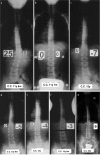Chêneau brace for adolescent idiopathic scoliosis: long-term results. Can it prevent surgery?
- PMID: 24043341
- PMCID: PMC3830030
- DOI: 10.1007/s00586-013-3020-1
Chêneau brace for adolescent idiopathic scoliosis: long-term results. Can it prevent surgery?
Abstract
Objective: The aim of this study was to evaluate the effectiveness of Chêneau brace in the management of idiopathic scoliosis.
Methods: This is a retrospective observational study according to SOSORT and SRS (Scoliosis Research Society) recommendations involving 48 girls with documented progressive idiopathic scoliosis, treated with Chêneau brace. A statistical analysis was performed with STATA MP11.2 to validate the obtained results.
Results: No patient needed surgery. The average curve angle measured in Cobb degrees passed from 27° ± 6.7° at the beginning (T0), to 7.6° ± 7.4° in brace (T1) (72 % of correction), to 8.5° ± 8.6° (69 % of correction) at the end of treatment (T2), to 11.0° ± 7.4° (59.3 % of correction) at final follow-up (mean 5 years and 5 months) (T3).
Conclusion: Conservative treatment with Chêneau brace and physiotherapy was effective in our hands for halting scoliosis progression in 100 % of patients.
Figures




Similar articles
-
Evaluation of the efficiency of the Chêneau brace on scoliosis deformity : A systematic review of the literature.Orthopade. 2018 Mar;47(3):198-204. doi: 10.1007/s00132-018-3529-4. Orthopade. 2018. PMID: 29392350 English.
-
The outcome of a modified version of the Cheneau brace in adolescent idiopathic scoliosis (AIS) based on SRS and SOSORT criteria: a retrospective study.Eur J Phys Rehabil Med. 2016 Oct;52(5):618-629. Epub 2016 May 4. Eur J Phys Rehabil Med. 2016. PMID: 27145218
-
Conservative treatment of adolescent idiopathic scoliosis: the effectiveness of rigid bracing.J Orthop Surg Res. 2025 May 16;20(1):464. doi: 10.1186/s13018-025-05743-x. J Orthop Surg Res. 2025. PMID: 40380287 Free PMC article.
-
Long-term Results of Conservative Therapy of Adolescent Idiopathic Scoliosis Using the Cheneau Brace.Klin Padiatr. 2019 Sep;231(5):248-254. doi: 10.1055/a-0963-8996. Epub 2019 Aug 13. Klin Padiatr. 2019. PMID: 31408904 English.
-
European braces widely used for conservative scoliosis treatment.Stud Health Technol Inform. 2010;158:157-66. Stud Health Technol Inform. 2010. PMID: 20543417 Review.
Cited by
-
Three-Dimensional Analysis of Initial Brace Correction in the Setting of Adolescent Idiopathic Scoliosis.J Clin Med. 2019 Oct 28;8(11):1804. doi: 10.3390/jcm8111804. J Clin Med. 2019. PMID: 31661811 Free PMC article.
-
The Role of Correction in the Conservative Treatment of Adolescent Idiopathic Scoliosis.Open Orthop J. 2017 Dec 29;11:1548-1557. doi: 10.2174/1874325001711011548. eCollection 2017. Open Orthop J. 2017. PMID: 29399228 Free PMC article. Review.
-
Does curve pattern impact on the effects of physiotherapeutic scoliosis specific exercises on Cobb angles of participants with adolescent idiopathic scoliosis: A prospective clinical trial with two years follow-up.PLoS One. 2021 Jan 25;16(1):e0245829. doi: 10.1371/journal.pone.0245829. eCollection 2021. PLoS One. 2021. PMID: 33493172 Free PMC article. Clinical Trial.
-
Evaluation of the efficiency of the Chêneau brace on scoliosis deformity : A systematic review of the literature.Orthopade. 2018 Mar;47(3):198-204. doi: 10.1007/s00132-018-3529-4. Orthopade. 2018. PMID: 29392350 English.
-
Brace treatment for patients with scoliosis: State of the art.S Afr J Physiother. 2021 Oct 26;77(2):1573. doi: 10.4102/sajp.v77i2.1573. eCollection 2021. S Afr J Physiother. 2021. PMID: 34859162 Free PMC article.
References
-
- Nachemson AL, Lonstein JE, Weinstein SL. Report of the prevalence and natural history committee of the scoliosis research society. Denver: Scoliosis Research Society; 1982.
-
- Chêneau J. Corset Chêneau. Manuel d’orthopédie des scolioses suivant la technique originale. Ed: Masson; 1994.
-
- Landauer F, Wimmer C. Therapieziel der Korsettbehandlung bei idiopathischer Adoleszentenskoliose. MOT. 2003;123:33–37.
Publication types
MeSH terms
LinkOut - more resources
Full Text Sources
Other Literature Sources
Medical

